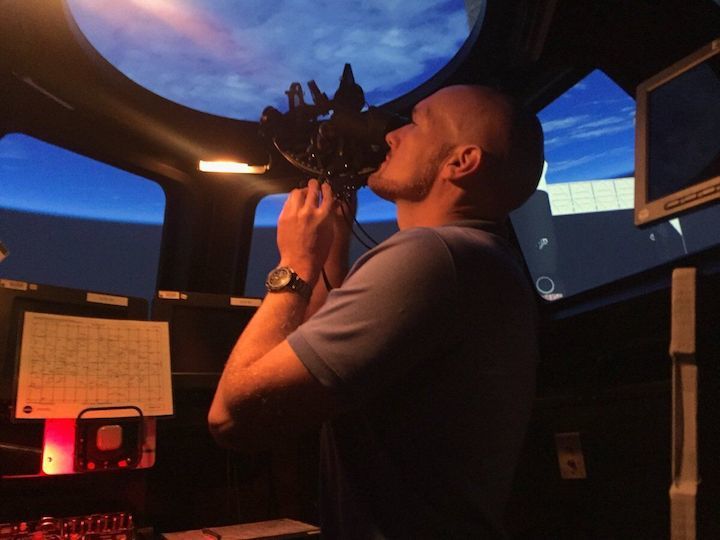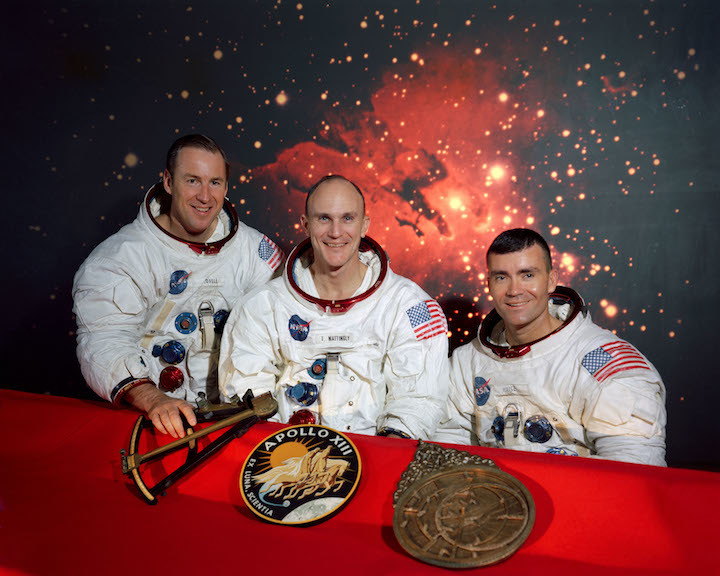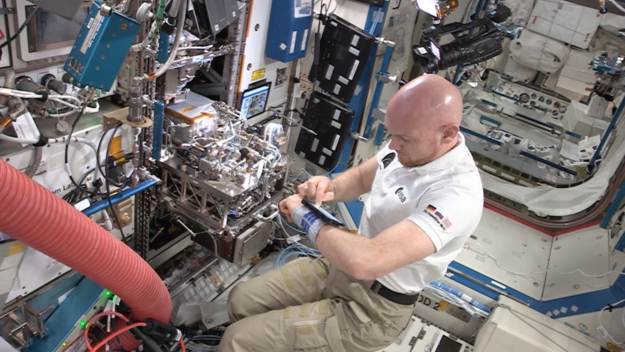A NASA astronaut will swap command of the International Space Station with a European Space Agency (ESA) astronaut Wednesday at 10:10 a.m. live on NASA TV. Expedition 56 Commander Drew Feustelwill be handing the station “keys” over to German astronaut Alexander Gerst during the traditional change of command ceremony.
Expedition 57 officially starts Thursday at 3:57 a.m. EDT when Feustel and Flight Engineer Ricky Arnold undock in the Soyuz MS-08 spacecraft commanded by cosmonaut Oleg Artemyev. Gerst, ESA’s second astronaut to command the station, is remaining onboard to lead Expedition 57 Flight Engineers Serena Auñón-Chancellor and Sergey Prokopyev. The homebound trio will parachute to a landing in Kazakhstan at 7:45 a.m. (5:45 p.m. Kazakhstan time) just two orbits after undocking and 197 days in space.
Astronaut Nick Hague from NASA’s astronaut class of 2014 and veteran station cosmonaut Alexey Ovchinin will be the next crew to blast off to the space station. The duo will launch Oct. 11 from the Baikonur Cosmodrome and take a six hour ride to their new home in space.
Amidst the crew departure activities today the station residents also worked space science and lab maintenance. Auñón-Chancellor worked on botany research inside the Plant Habitat located in the Columbus lab module. Gerst worked on hardware for the mobiPV study that is researching ways to increase productivity between astronauts and mission controllers. Departing astronauts Arnold and Feustel cleaned up their crew quarters.
Glad our friends are fine. Thanks to the rescue force of >1000 SAR professionals! Today showed again what an amazing vehicle the #Soyuz is, to be able to safe the crew from such a failure. Spaceflight is hard. And we must keep trying for the benefit of humankind.#Exp57 #SoyuzMS10

This morning's #Soyuz launch failure was captured on camera from the ISS by @Astro_Alex.

Dieses Bild der beiden Raumfahrer aus Russland und USA, die heute im #Sojus-Raumschiff saßen, braucht - glaub' ich - keine weitere Erklärung.

INSTALLING LIFE SUPPORT THE HANDS-FREE WAY

Last week saw the installation of ESA’s next-generation life-support system on the International Space Station. The new facility recycles carbon dioxide in the air into water that can then be converted into oxygen reducing supplies sent from Earth by half.
Installing the life support rack in NASA’s Destiny laboratory is no easy task as the facility is larger than a human being and weighs over 650 kg on Earth. In addition many cables and pipes need to be connected to the Station’s infrastructure – including a pipe that vents waste methane from the recycling process directly into space.
ESA astronaut Alexander Gerst set up the air and water drawer of the facility, including part of the Sabatier reactor on 10 September but was given an extra helping hand from ground control with an operational aid called the ‘mobile procedure viewer’ or mobiPV.
Usually an astronaut would have a computer nearby with step-by-step instructions to follow, but anybody who has tried repairing their car or even assembling furniture will agree this way of working has room for improvement – laying down tools to consult instructions is time-consuming and interrupts the work flow.
ESA’s solution to this problem sees astronauts wearing a smartphone on their wrist that connects to the Space Station’s procedure library and shows the instructions on-screen. Alexander could concentrate on the work at hand, without going back and forth to the computer.
Three sites in Germany were all connected and had full awareness of the installation as Alexander progressed step-by-step: the Columbus Control Centre near Munich, the European Astronaut Centre near Cologne and the facilities’ manufacturer Airbus in Friedrichshafen.
The mobile procedure viewer might seem simple but space operations allow little room for error and overcome technological challenges.
As the Space Station orbits Earth it loses radio contact for periods of up to eight minutes at a time. Alexander continued working during the periodic loss of signal but once communications were reestablished, mobiPV automatically and quickly brought all four teams up to speed.
Alexander worked efficiently with support from experts on ground throughout installation commenting during the experiment: “Great work to the whole development team. I did the whole procedure off mobiPV and it worked even better than I expected.”
David Martínez, lead ESA engineer for MobiPV comments "It was a great day to see our product work so well to help an astronaut install such complex hardware in space, making his life easier and also doing our part for future exploration."
As humans venture farther from Earth such as to a lunar gateway, life-support and communication with ground control will only become more challenging but last week’s operations on the Space Station are paving the way for exploration of our Solar System where greater autonomy and hands-free operations are important for planetary operations
Quelle: ESA
---
Update: 4.11.2018
.
Fans of science in space now can experience fast-moving footage in even higher definition as NASA and ESA (European Space Agency) deliver the first 8K ultra high definition (UHD) video of astronauts living, working and conducting research from the International Space Station. The same engineers who sent high-definition (HD) cameras, 3D cameras, and a camera capable of recording 4K footage to the space station now have delivered a new camera capable of recording images with four times the resolution than previously offered.
The Helium 8K camera by RED, a digital cinema company, is capable of shooting at resolutions ranging from conventional HDTV up to 8K, specifically 8192 x 4320 pixels. By comparison, the average HD consumer television displays up to 1920 x 1080 pixels of resolution, and digital cinemas typically project in resolutions of 2K to 4K.
“This new footage showcases the story of human spaceflight in more vivid detail than ever before,” said Dylan Mathis, communications manager for the International Space Station Program at NASA’s Johnson Space Center in Houston. “The world of camera technology continues to progress, and seeing our planet in high fidelity is always welcome. We're excited to see what imagery comes down in the future.”
Viewers can watch as crew members advance DNA sequencing in space with the BEST investigation, study dynamic forces between sediment particles with BCAT-CS, learn about genetic differences in space-grown and Earth-grown plants with Plant Habitat-1, observe low-speed water jets to improve combustion processes within engines with Atomization; and explore station facilities such as the MELFI, the Plant Habitat, the Life Support Rack, the JEM Airlock and the Canadarm2.
While the 4K camera brought beautiful footage of fluid behavior in the space station’s microgravity environment to the world, the new 8K video takes viewers through a variety of experiments and facilities aboard the orbiting outpost, which on Friday, Nov. 2 will celebrate the 18th anniversary of humans living continuously aboard and the 20th anniversary of the launch of the first two space station elements on Nov. 20 and Dec. 4, 1998, respectively.
Delivered to the station in April aboard the 14th SpaceX cargo resupply mission through a Space Act Agreement between NASA and RED, this camera’s ability to record twice the pixels and at resolutions four times higher than the 4K camera brings science in orbit into the homes, laboratories and classrooms of everyone on Earth.
“We’re excited to embrace new technology that improves our ability to engage our audiences in space station research,” said David Brady, assistant program scientist for the International Space Station Program Science Office at Johnson. “Each improvement in imagery fidelity brings that person on Earth closer to the in-space experience, allowing them to see what human spaceflight is doing to improve their life, as well as enable humanity to explore the universe.”
The RED camera is the same brand used to record theatrical releases such as The Hobbit trilogy, Guardians of the Galaxy Volume 2, and television programs such as, Stranger Things, Maniac, and Lost in Space.
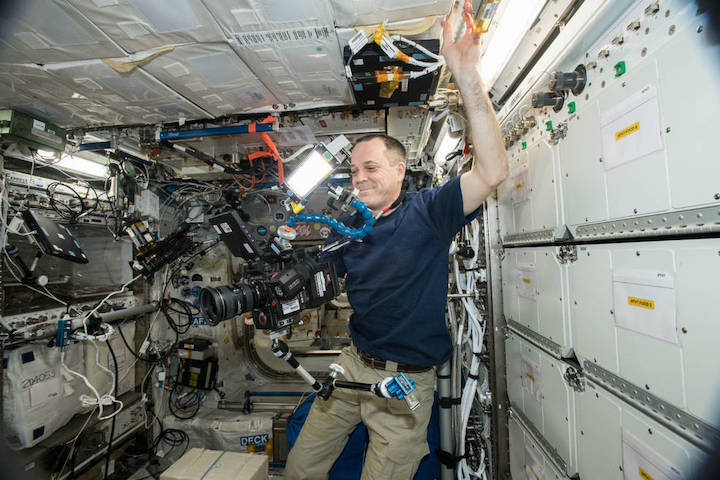
Astronaut Basks in Earth's 'Glory' Rainbow from Space Station (Photo)
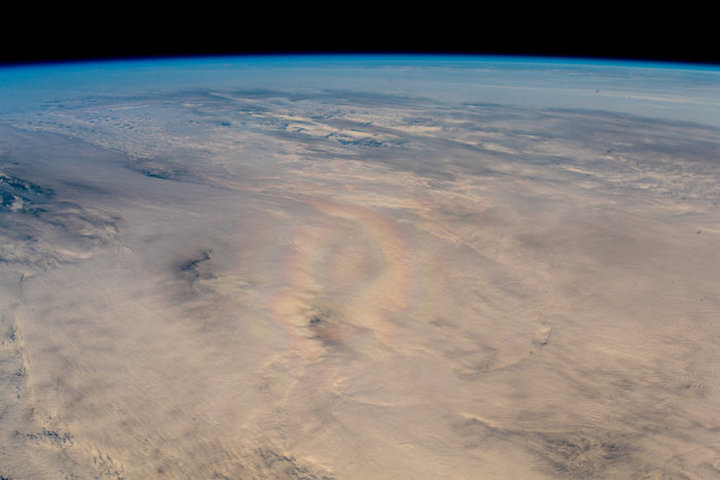
Credit: ESA/NASA
European astronaut Alexander Gerst was surprised to see a circular, rainbow-like gleam — a phenomenon known as a glory — in the clouds below the International Space Station on Sept. 14, 2018.
He snapped a couple photos of the colorful glow, posting the shots to Twitter on Tuesday (Nov. 6). In a statement, the European Space Agency (ESA) explained the rarity of a glory, which results from sunlight bouncing off droplets of water in a particular way.
Because the phenomenon relies on specific atmospheric conditions, it's most commonly reported at relatively high altitudes by mountain climbers and pilots, but not usually quite as high as the space station. While they're living in the orbiting laboratory, astronauts are about 250 miles (400 kilometers) above Earth's surface.

ESA didn't provide any additional details about how a glory could form so high up, but Gerst's image could prompt deeper investigations.
"Sometimes, a simple photograph can spark scientific investigation or even full-blown scientific research," the ESA statement said. "Alexander's pictures of aurora[s] from his last mission in 2014 are adding extra information for researchers analyzing these beautiful atmospheric displays of light."
Analysis aside, let's all take a moment to glory in the beauty of this atmospheric phenomenon.
Quelle: SC
---
Update: 18.11.2018
.
HALLO CIMON

Das Experiment Cimon, kurz für Crew Interactive Mobile CompanioN, wurde entwickelt, um die Interaktion zwischen Mensch und Maschine im All zu testen. Im Auftrag des DLR ist Airbus in Friedrichhafen und Bremen für Entwicklung und Bau von Cimon zuständig. Für die wissenschaftlichen Aspekte des Projekts ist das Klinikum der Ludwig-Maximilians-Universität München (LMU) verantwortlich. Cimon verwendet auch die cloudbasierte Künstliche-Intelligenz (KI) Software IBM Watson.
Cimon wiegt etwa 5 Kilogramm und besitzt ein Display. Mithilfe des Technologieexperiments soll die Arbeit von Astronautinnen und Astronauten unterstützt und Effizienz gesteigert werden. Hierzu werden Informationen, die für die Durchführung wissenschaftlicher Experimente und Reparaturen benötigt werden, auf Cimons Bildschirm angezeigt und erläutert.
Das Experiment Cimon kann darüber hinaus mobil Fotos und Videos aufnehmen, Experimente dokumentieren, Objekte suchen und Inventar führen. Cimon kann sehen, hören und verstehen, was es beobachtet. Der Technologiedemonstrator ist zudem mit einem autonomen Navigationssystem ausgestattet, sodass Alexander Gerst Sprachbefehle geben kann, ähnlich wie bei den bekannten virtuellen Assistenten Alexa, Siri oder Cortana.
Nachdem Alexander am Donnerstag, den 15. November, auf der Internationalen Raumstation ISS Cimon aus seiner Box nahm, erweckte er das Experiment mit den Worten „Wach auf, Cimon!“. Cimon antwortete darauf mit der folgenden Frage: „Was kann ich für dich tun?“. (Anmerkung der Redaktion: Sprachkommando sowie Antwort erfolgten in englischer Sprache).
Während des ersten Ausflugs auf der ISS demonstrierte Cimon einige seiner Fähigkeiten: Es suchte und erkannte Alexander Gersts Gesicht, nahm Fotos und Videos auf, zeigte Anweisungen für ein Schülerexperiment zur Kristallbildung sowie einen Clip zur Lösung eines Zauberwürfels. Auf Alexander Gersts Wunsch spielte er ebenfalls eines seiner Lieblingslieder ab – natürlich war es ein Track von Kraftwerk.
Alle Beteiligten sind zufrieden mit dem Technologieexperiment. Daher hoffen sowohl Cimons Entwickler als auch Alexander Gerst Cimon bald wieder in Aktion zu sehen. Obwohl während der aktuellen Horizons-Mission vorerst keine weiteren Einsätze geplant sind, könnte dieses Experiment den Beginn einer spannenden Zusammenarbeit zwischen Astronauten, Roboterassistenten und möglichen zukünftigen Künstlichen Intelligenz-Anwendungen im Weltraum markieren.
Credits: ESA/NASA
Quelle: ESA



